“For last year’s words belong to last year’s language, and next year’s words await another voice.” –T.S. Eliot, Four Quartets.
2013 was a great year for the U.S. equity investor. In 2013, U.S. equity markets were up more than 30%, a return that dwarfed the expectations of every investment forecaster. On the other hand, U.S. bond markets dropped 2.0%, the first annual loss in 14 years and the largest loss since 1994.
U.S. equities outperformed every other major asset class by more than 10%. One has to go back sixteen years to find the last time that U.S. equities outperformed every other major asset category over a full year cycle. Almost every other asset category had average or below average years.
U.S. equity markets again posted strong results in the fourth quarter with all major indices achieving measurable gains. Performance was skewed towards larger capitalization stocks as large caps outperformed small cap stocks.
Large growth outperformed value and blend, and small value outperformed small growth and blend. Value trailed growth in large cap but outperformed in small and mid cap. Large Cap growth grew by 10.4% for the quarter (Russell 1000 Growth). For the year, small cap growth (43.3%) led the markets while large cap blend returned the least (albeit a very respectable 32.4%).
Foreign equities underperformed their U.S. counterparts in both local currency and U.S. dollars. The U.S. dollar weakened 0.2% for the quarter versus a basket of six major trading partners’ currencies as signs of recovery emerged in Europe. For the year, the US dollar was modestly stronger, up 0.3%.
Developed markets small caps were the best performing asset class broad global equity as the MSCI EAFE Small Cap Index rose more than 29% for the year and 5.9% for the quarter. For the year, European markets were up 28.7% (Europe ex UK) with the UK up 20.7%, Germany up 32.4% and France up 27.7%.
In the Pacific region, Japan returned 27.3% for the year (54.8% in local terms) and the rest of the Pacific region returned 5.6%, all in dollar terms. Emerging markets equities continued to be significant laggards relative to much of the developed world, up 1.9% for the quarter but down 2.3% for the year.
The largest emerging markets posted mixed results for the year with returns for Brazil -15.8%, Russia +1.4%, China +4.0% and India -3.8%, all in U.S. dollar terms.
Domestic Fixed Income
| Barclays Bond Indices | Q4 2013 | 2013 |
| U.S Aggregate | -0.1% | -2.0% |
| U.S Treasury 7-10 yr | -1.9% | -6.0% |
| U.S Treasury TIPS | -2.0% | -8.6% |
| U.S Gov’t / Credit | 0.0% | -2.3% |
For the year, bond investors suffered as rising interest rates around much of the globe led to losses for most fixed income indices. The yield on the 10-year U.S. Treasury bond closed at a high for the year (3.04%); about 125 basis points above its level 12 months prior and its highest level since July 2011.
The Barclays Aggregate Bond Index suffered its first yearly loss since 1999 and its worst return since 1994. Long bond indices, a key benchmark for many pension plans, suffered sizable losses. Foreign bonds performed more poorly than their US counterparts in local terms; however, a strong US dollar buoyed hedged returns into positive territory. Emerging markets bonds produced sharply negative results in their first annual loss since 2008.
Municipal bonds, despite some high profile credit events, fell only fractionally for the year. High yield was the only bright spot for fixed income investors in 2013 and widely outpaced investment grade debt. The Treasury Inflation-Protected Securities (TIPS) market lost further ground to U.S Treasuries, off 2.0% for the quarter and 8.6% for the year as fears of inflation diminished, despite record monetary easing.
Interest Rates and Inflation
| 10 Year Treasury Rates | |
| Dec 31, 2012 | 1.78% |
| June 28, 2013 | 2.52% |
| September 30, 2013 | 2.64% |
| December 31, 2013 | 3.04% |
| 50 year average | 6.66% |
| 10 year average | 3.51% |
The 10-year U.S. Treasury rate rose to 3.04% on the last day of 2013, the highest level in since July 2011. The announcement of modest monetary tapering on December 18th from $85 billion per month to $75 billion per month had a nominal effect on rates but caused longer duration assets to lose any gains from the beginning of the quarter.
Even as interest rates have increased, global inflation has remained low, as US inflation rate for the 12 months ended November 29, 2013 stood at 1.2%. The primary reason that inflation has remained low in this recovery is that the velocity of money (the amount of nominal GDP created by each dollar of the money supply) has dropped significantly since the beginning of the Great Recession.
Most recoveries of the post-WWII era have seen increased velocity of money, typically after some period of economic growth. Possible factors driving an increase in velocity include improvement in consumer confidence, a slowdown in the rate of money growth (tapering), and improved bond credit quality.
If the velocity of money increases from its current low levels then we should see an increase in inflation expectations. However, until we see evidence of increased velocity, which we have not yet witnessed, we expect that inflation will remain low in early 2014 and gradually increase as velocity returns to more normal levels later in the year. Low inflation expectations contributed to poor performance of inflation-protected security and commodities in 2013.
Looking forward, we do not expect the U.S. equity market to deliver 2013 returns. The major drivers of 2014 global equity performance will be the economy, the actions of the central banks, and valuations.
In the U.S., we are optimistic about the economy and expect increasing growth from increased consumption (the wealth effect), increased business investment spending, a continuing housing recovery, and some increase in exports.
The Fed will continue monetary tapering but will leave short term rates near zero. While less accommodative, tapering is still an expansionary monetary policy. From a valuation perspective, U.S. equities are still below their 15 year average forward PE ratio (15.4 x 16.5) and the dividend yield is still in excess of investment grade bond yields as of the end of 2013.
All of these factors contribute to our view that the US equity market can continue to perform in excess of bonds, albeit at a lower, more normal rate of return.
The factors driving U.S. equity performance also drive international expectations. The developed market economies have shown modest improvement in growth and Europe in particular could benefit from increased economic activity.
The European Central Bank’s support of Europe’s peripheral sovereign debt countries is a major factor in increasing confidence in the sovereign debt markets. Increased manufacturing, and some modest improvement in consumer sentiment will also contribute to European growth.
One of the themes of 2013 was the lifting of economic and political uncertainty in the U.S., which in part led to the U.S. equity rally. In general, the lifting of uncertainty is a positive for markets and there appear to be more factors favoring markets than the opposite.
With the exception of uncertainty related to the Affordable Care Act, Washington appears to have lowered some of the political wrangling of the past two years – we are more positive in this regard than we have been in the recent past.
When we examine 2013 from an asset allocation perspective, exposure away from U.S. equities and towards risk assets such as emerging markets, REITs, commodities and long term bonds, detracted from overall portfolio performance.
Our expectation with regard to fixed income is that we are likely in for another round of increasing interest rates, contributing to a modest drag on longer duration assets, but do not expect a rapid rise in rates nor as large a drop in valuations as we observed in 2013. Near-zero returns should be our lot for 2014 in the aggregate bond market.
Last year’s words are last year’s language. U.S. equity returns were phenomenal and all investors, including global asset allocation investors, benefited from this anomaly.
This year, we expect that an optimally diversified strategy of global assets will fall somewhere in the middle of a wide range of investment outcomes, and that this approach will lead to reduced investment risk, more certain outcomes and better risk adjusted returns. This year’s narrative remains the same, that long term success in outcome is tied to a globally diversified portfolio allocation strategy.
DISCLAIMER: The information in this material is not intended to be personalized financial advice and should not be solely relied on for making financial decisions. All investments involve risk, the amount of which may vary significantly. Investors cannot invest directly in an index. Indexes have no fees. Past performance is no guarantee of future results.




